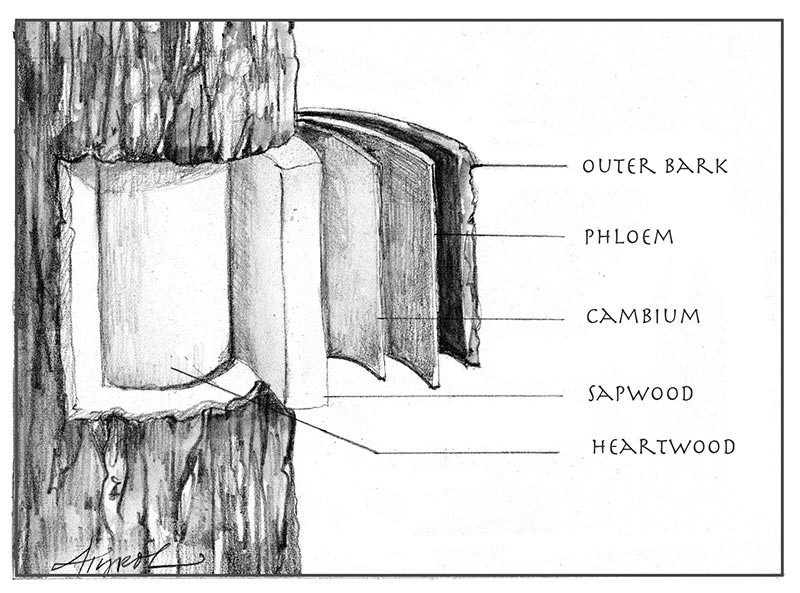
It’s winter. Hardwood trees are bare. But that doesn’t mean the woods are bereft of interest. Winter, when sunlight slants in, is the time when bark comes into its own. Pause to take in the aged-brass bark of a yellow birch, or the hand-sized bark plates on a big white pine.
Bark is beautiful. And practical. A protective tissue, a defense against insects, fungi, fire, and deer, it has a lot in common with human skin.
Bark includes a cork layer of dead cells — the bark you see — and the cork cambium, made up of living cells. A layer deeper lies the inner bark, or phloem, which helps move sugars and other biomolecules through the tree. The inner bark is renewed by outward cell division of the vascular cambium; inward division of the vascular cambium creates sapwood.
The basic layers are the same for most trees and woody shrubs, said Kevin Smith, a supervisory plant physiologist at the U.S. Forest Service’s Northern Research Station, but “there’s a lot of variation that comes into play” depending on tree species, location, what the climate is, and the threats a tree encounters.
Some species, like ponderosa pine or Scots pine, put a lot of energy into creating thick outer bark to protect themselves from fire. Others put more effort into protecting against insects: balsam firs have bark studded with resin ducts that serve as bug traps.
Many varieties of trees are consummate chemists, larding their bark with protective compounds. Oaks, American chestnuts and hemlocks produce large amounts of tannins, bitter chemicals that deter insects. Ironically, these same compounds increased predation by humans, who for centuries used them to tan leather.
Tannins aren’t the only thing tree bark has given us: willow bark yielded the first aspirin; the anti-malarial compound quinine came from the cinchona tree; we cork our wine bottles with the outer bark of a southern European oak. And, of course, there’s that symbol of the North Woods, the birchbark canoe.
When trees are young it can be a little hard to identify them by their bark. Most small trees have smooth bark, but bark tends to get more distinctive as a tree ages. Smith said most species put more energy into developing their bark layer as they age. The bark of many older trees develops big plates or fissures. Smith explained that these trees are working to protect themselves by thickening parts of their bark, but they also need “to have thinner areas for gas exchange, the opportunity for breathing.”
That’s right, trees breathe through their bark, taking in oxygen and giving off carbon dioxide to fuel the cell division in the vascular cambium. So, you could say that the tree is breathing through its skin like frogs or salamanders.
Those deep fissures in the bark of older trees can be an ecosystem in themselves, with insects, fungi, mosses, epiphytes, and various kinds of invertebrates all calling it home.
Another characteristic of bark is that it can grow over places where limbs have fallen off or there has been damage. Unlike human skin, trees don’t heal wounds; any dead cells will always be present, but the cambium and bark encapsulate them, keeping injury to a minimum. That’s a necessary adaptation, said Smith, since trees have evolved to shed excess branches that aren’t collecting enough light.
“Bark is also shed,” he said. “Part of that is protective, to keep bugs or fungi from getting too much of a foothold.”
Openings in a tree’s bark can be pathways for infection by fungi and microbes. And also insects, which are always looking to exploit vulnerabilities. An entire class of beetles known as bark boring beetles preys on trees, feeding and reproducing in the inner bark and often weakening or even killing the tree.
While a thick rind of bark can protect some tree species’ vulnerable cambium from fire, much less is known about how bark helps trees cope with brutal winters, said Smith. “Bark does have a thermal insulating property,” he said, but not much research has been done on how effective it is.
Smith said it’s worth getting to know trees by their bark, since it gives you a way to identify them at a time when the leaves aren’t out. Plus, bark is beautiful. His favorites? “The paper birch, of course. The deeply furrowed bark of a mature sugar maple gives it a lot of character. And there’s a shagbark hickory I go by on my way to work. I love the bark that exfoliates away from the stem.”


Discussion *